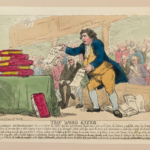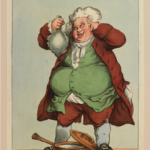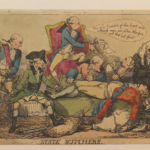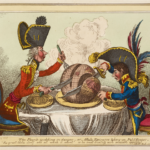Curious Taste: The Transatlantic Appeal of Satire
By Nancy Siegel
Professor of Art History and Culinary History
Towson University
Towson, MD
Queen Charlotte frying sprats, George III toasting muffins or placing a fleet of ships in an oven about to be baked like gingerbread, the Prince of Wales gorging himself on the fortunes of Empire, William Pitt carving plum pudding with Napoleon, the American colonies represented as a kettle of fish, and of course the roast beef of England—metaphors and similes linking politics to consumption formed the basis for select satirists to create a distinct genre of prints promoting criticism and dissent. From the mid-eighteenth through the early nineteenth century, these artists deployed a culinary vocabulary as their visual language to mock the royal family, nobility, and aristocrats. Whether the British Empire was referred to as a cake or a kettle of fish, the domestic language of food was easily understood by audiences with varied socio-economic and cultural backgrounds. My research posits that culinary iconography found in eighteenth-century prints is more than merely humor-driven with its easily recognizable foodstuffs. While visually delightful and endlessly comedic, what lies beneath this façade of satire is pointed disgust and outrage. The comestibles employed to mock, deride, and ridicule members of the royal family and parliament expose subtexts that read as political and economic markers of trade and commerce.
From the means by which these works traveled, to the print sellers and collectors who found value in image and in text, the dissemination of British political satire is the focus of my study. Between 1774 and 1783 well over one hundred print shops and print sellers advertised satirical images through shop displays, advertisements, and sale. Such prints were published in Britain during the “golden age of caricature,” and were consumed, circulated, collected, andpresented in various ways for a growing consumer audience. Through an exploration of how the visual culture of satirical prints functioned in the late eighteenth and early nineteenth centuries, my research addresses inquiries such as how were collections made (in particular the Royal Collection), and by what means were these prints advertised, displayed, and discussed? Commenting on current events, contemporary affairs, public figures, and politicos, these works sparked debate and demonstrate the manner in which print culture served as a disseminating voice for artists to express criticism and dissent during the turbulent end of the eighteenth and beginning of the nineteenth century.
Within this golden age of caricature two notable artists stand out: James Gillray and Thomas Rowlandson. Giving visual expression in bawdy form to the body politic popularized public taste and increased demand for etchings and engravings in which formidable figures were called to task. Satirists such as Gillray and Rowlandson were well aware of their authority in the public eye. Their depictions of tea, gluttony or starvation, pork, beef, and bread whether butchered, consumed, or baked spoke to the conditions and events that ultimately dismantled the Empire: non-importation movements in the American colonies, food riots in London and the surrounding countryside, complex trade embargoes, protests over taxation, and ultimately revolution. Satires of wealth and abundance with titles such as A Slice of Gloucester Cheese, Fat Cattle, Delicious Dreams, Studious Gluttons, and Uncorking Old Sherry were complements to more ominous messages found in Butchers of Freedom, The Plum Pudding in Danger, Scottifiying the Palate, Germans Eating Sourkraut, or Jews at a Luncheon. This sub-genre within the field of political satire utilized a common vocabulary with palatable imagery to reveal the complex political state of affairs. To feed the body politic, literally and figuratively, was the means by which the British Empire would expand its control internationally but ultimately falter due to corruption and economic conflict. This project, Curious Taste: The Transatlantic Appeal of Satire, examines how and why a culinary vocabulary developed and was employed as a widespread, but little studied, language of political expression to critique, expose, and excoriate in the years surrounding the authority of George III.
One might ask, how many of these culinary-inspired prints made their way to royal or aristocratic collections? The answer—the overwhelming majority. George III and the Prince of Wales were prolific collectors of satirical prints and amassed enormous collections of satires despite serving as the subject for myriad diplomatic caricatures. Not framed and displayed as was the practice for some, but kept in folios often arranged by date of acquisition if not event, collecting satire was a means for the royal family to keep abreast of public discourse and discord—equally important for a governing body often in the midst of internal conflict. Whether collected privately or seen in shop windows as a means of public broadcast, the individuals appearing as the focus of this disaffection were keenly aware of the agency asserted by mass produced prints. Vast correspondence in the Royal Archives demonstrates that to the Prince of Wales print sellers sold hundreds of portraits, fanciful images, and theatrical scenes, but also political satires that fed his fascination with figures such as Napoleon Bonaparte. Ever sensitive to his public image, he at times even attempted to suppress satires he deemed too scandalous for his reputation. A large collection of correspondence related to these suppressed prints also in the Royal Archives provides the detailed orders by the Prince to buy up existing etchings, have plates destroyed, and otherwise attempt to protect his reputation. Of course, these efforts were rather futile as print sellers immediately commissioned new and even more rabid imagery in response to attempted censorship.
The trope of consumption was readily parodied by satirists as found in the print collection at Windsor Castle. Numerous receipts in the Royal Archives relate to the purchase of art and the Royal Collection of Prints and Drawings contains important folios of Thomas Rowlandson prints in which culinary imagery is prevalent. Rowlandson’s The Word Eater (1788), for example, depicts Fox in the House of Commons explaining how he will devour words, speeches, and books (“all these I’ll devour next” he says). Here he is mocked for twisting words and manipulating documents such as the Magna Carta in support of the Prince of Wales’s efforts. The Epicure (1804), is a thinly veiled reference to Lord North, and State Butchers (1789), both in the Royal Collection, satirizes the Prince of Wales who is laid out on a bench about to be butchered by Tory peers, under the direction of William Pitt who instructs the party to begin by cutting out the Prince’s heart, saying, “The good qualities of his heart will certainly ruin our plan, therefore cut that out first.” Receipts from the Prince of Wales show that he purchased both James Gillray’s Uncorking Old Sherry and Plumb Pudding in Danger from print seller Hannah Humphrey with whom he had an arrangement to deliver prints between March 25-June 26th of 1805. In Plumb Pudding, Prime Minister Pitt and Napoleon are depicted in the process of carving up a pudding representative of the empires they seek to control. Pitt uses knife and fork to slice a piece of ocean, while Napoleon carves off Europe for himself. This print, published in 1805, was produced soon after Napoleon became Emperor in December,1804, making this a timely purchase for the Prince of Wales.
- Thomas Rowlandson, The Word Eater, Dec. 30, 1788, pub by S Fores
- Thomas Rowlandson, The Epicure, Jan 1st, 1804, first issued in 1788, reissued by Fores in 1801
- Thomas Rowlandson, State Butchers, 1789
- James Gillray, The Plumb-pudding in Danger- or- States Epicure taking un Petit Souper, pub by Hannah Humphrey, 1805
In terms of supplemental culinary materials, I reviewed cookbooks and receipt books from the 1760s-1820s in the Royal Library, and supply records from the kitchens, gardens, farm estates, and mensil books in the Royal Archives. I have mined correspondence and official papers for mention or discussion of commodities imported from the American colonies and commodities exported to the American colonies such as fish, tea, rum, and sugar in order to pair political discussions of commodities with the culinary iconography found in satirical prints. The discussion of such comestibles as found in the correspondence of George III dovetails with the visual language employed by satirists. For example, State Cooks, or the downfall of the fish kettle, shows George III, with his back to a fireplace, and Lord North standing between an overturned kettle of fish—each labeled with a specific colony. Why are fish employed to represent the colonies? Referring to the lucrative fishing trade in North America, this image pairs well with letters in the Royal Archives from the King to North in which restraining the trade and fishery in New England is discussed. George III says, “O Boreas, the loss of these fish will ruin us forever,” thusly acknowledging the economic importance of the colonies. Likewise, the Royal Library is a rich resource for archival materials relating to commodities, consumption, and culinary discourse. A wonderful example was found in the Autograph Letters from the Correspondence of John Jay from 1776 to 1794. Dated 31 July, 1783 from Alexander Hamilton on “the peace exceeding in the goodness of its terms the expectations of the most sanguine—and the proposal” he writes, “The New England people talk of making you an annual fish-offering as an acknowledgement of your exertions for the participation of the fisheries.”
Associations between the ingredients and naming of recipes relative to political satires factor large in my study. Seminal prints such as The able Doctor, or America Swallowing the Bitter Draught, printed in the London Magazine in May 1774, depicts Lord North (who closed Boston’s Port after the famed Tea Party) forcing tea down the throat of America, here personified as a Native woman who attempts to spit the tea violently back into his face. Her arms and legs are restrained while the Earl of Sandwich peers up her dress. The bitter draught is here thought to refer to imported tea. However, in the Royal Library is a Collection of Receipts; vizt for preserving, jellys, cakes, sweetmeats, cookery, pastry, wines, cordial waters, surgery and physick, 1727 (1164539 AM) containing multiple recipes for Bitter Draught—an herbal tea served hot, capitalizing on the medicinal properties of wormwood, gentian root, chamomile flowers, and cardamom seeds. Brought to a boil and consumed twice a day this curative brew eased an array of ailments but most commonly as a digestive and for gastrointestinal distress. Identified by the off-putting taste and hallucinogenic properties associated with wormwood and the bitter gentian root, finding this recipe in a hand-written compendium suggests that references to bitter draught would have been clearly well-known and associated with distress. Thusly, in the engraving, also copied by Paul Revere as the frontispiece for the Royal American Magazine in Boston, the familiar digestive is equated with the now politically charged beverage—a contested brew, as the foul-tasting potion difficult to swallow, demonstrating British sympathies for hard to digest polices and taxes. So too, George’s letters in the Royal Archives contain much related to the Stamp Act, the financial condition of the East India Company, and the non-importation of commodities such as tea. Some of the more surprising moments while conducting research in the Royal Archives includes the splendid joy of reading the personal letters of George III and how he endeavored to create intimate relationships with those in his circle. In particular, correspondence between the King and Lord North were particularly revealing as to George’s sensitive nature. He cared most sincerely for the well-being and health of those closest to him and it quickly became apparent that his personal interest in those around him formed the basis for his, at times, blind trust.
The work I conducted at Windsor Castle will be valuable for two current projects. In addition to contributing to a book-length manuscript I am completing, Political Appetites: Revolution, Taste, and Culinary Activism in the Early Republic, the results of this research will also take the form of a published essay titled, “Feeding the Body Politic: Culinary Satire in the Reign of George III,” in the exhibition catalogue Curious Taste: The Transatlantic Appeal of Satire, an international exhibition in development for 2022. The premise for the exhibition includes a selection of 40+ eighteenth-century British satirical prints selected from two American research institutions with an emphasis on the collectors responsible for the works we now highly regard. In an innovative approach, the collections from these American centers will travel to two European venues—one in Britain and one in Germany, fostering the narrative on taste making while exploring the cultural and long-standing appeal of British satire. As our British and German colleagues consider new approaches to highlighting their collections and telling the stories of their collectors, the exhibition becomes a movable narrative; the story becomes richer within an international context bringing together works with a synchronicity that explore the lives of these prints as objects that were purchased, transported, and collected across time and geographical borders.
The generous award from the Georgian Papers Programme Fellowship defrayed the cost of airfare and provided for a lovely Air B&B, in addition to covering daily expenses for a month of research. At the Royal Archives, the Royal Library, and the Royal Collection of Prints and Drawings, I accessed the private, unpublished correspondence of George III, the Prince of Wales, and members of the royal family including Queen Charlotte, Princess Royal Charlotte, plus correspondence of ladies of the court who discussed their private lives and expressed concern regarding public opinion. I also researched the correspondence and financial papers of the Prince of Wales for bills and purchases for art including satires in addition to the letters regarding his efforts to suppress a number of scandalous prints. Likewise, I consulted Georgian mensils for commodities used at Windsor Castle, receipt books and culinary manuscripts in the Royal Library, and the collection of Thomas Rowlandson prints amassed by the royal family in which culinary imagery is prevalent in satirical form.
The following list summarizes some of the more significant resources I consulted during my time in residence as a Georgian Papers Programme Fellow:
At the Royal Archives:
- GEO/MAIN 1346-1711 George III: Calendar. July 1772-December 1775 (previous years available online)
- GEO/MAIN George III Calendar, Jan 1774-Aug 1775; 2104
- GEO/MAIN George III Calendar – Sept 1775- Oct 1777: 2385
- Essay George III: America is Lost! Must we fall beneath the blow?
- GEO/MAIN George III Calendar: March 1781-January 1781
- GEO/MAIN 26786-27093, 27094-27397 Geo IV Accounts Pictures & Enamels
- 57382(a) Private Papers of George IV: caricatures suppressed
- 57382(a) Private Papers of George IV: caricatures suppressed
- GEO/MAIN 26460-26785; 1799-1835 George IV Accounts: Papers, Pictures and Statuary
- Prince of Wales- Regency Calendar July-December 1812
- Princes Charlotte’s Mensil Books, 1814-1816
- MRH/MRHF/GOODSREC/KITCHEN/CHARLOTTE “Her Royal Highness Princess Charlotte’s Kitchen”
- Lady Ashbrook Papers (Acc. 147A-B, 299) ADD. 49/1-67, 1813-1851
- Letters between Lady Ashbrook and Princess Charlotte (1796-1817)
- GEO Additional MSS.37: Miss Ann Hayman Papers 1796-1820, 1-101
- Starts with vicious collection of letters between the Prince of Wales and Princess Caroline.
- Mr. Cordall Powell Papers: ADDL MSS Geo 15- 862-878
- appointed librarian to the Prince of Wales. Sept. 18, 1783
- Mrs. Bayne’s Papers: Georgian Additional MSS. 15. 1777-1830 (GEO/ADD15?914-1089
- 51382 (a) George IV Private Papers: List of suppressed Caricatures with receipts for sums paid 1819-1822




